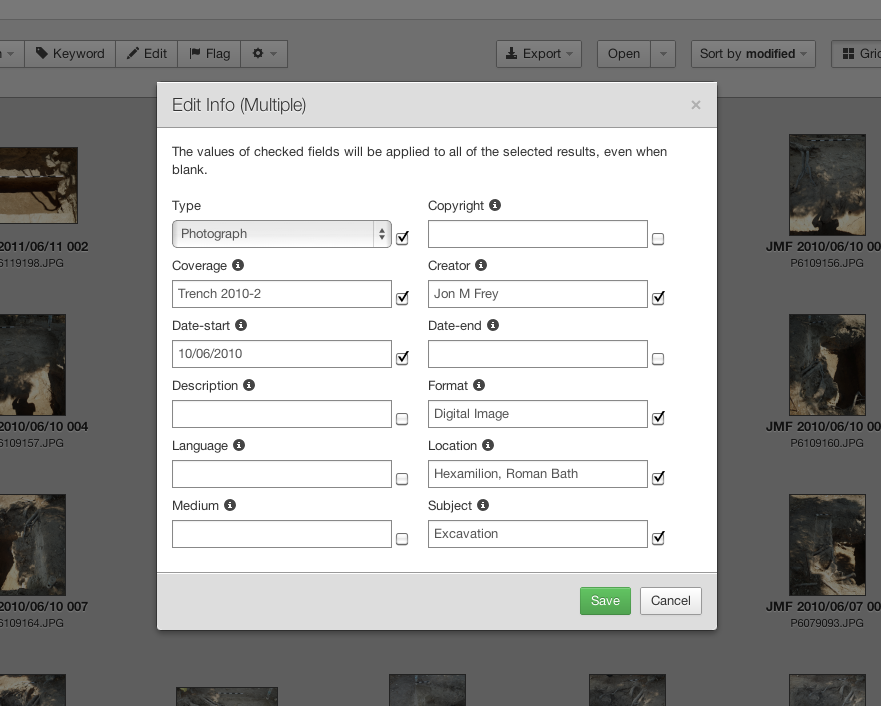Bulk Actions
One of the key features of ARCS is the ability to map an action onto a large number of resources. ARCS allows you to edit, flag, keyword, download, open, preview and much more--en masse. This functionality is exposed through our search interface.
All of the bulk actions are accessible through the toolbar:
Selection
Before you can do anything, you'll need to select some resources. If you've ever selected files on your Mac or PC's desktop, you'll be right at home.
Click on a resource to select it. Drag over a group of resources to select them all. To select a resource without deselecting the others, hold down the control (or command) key and click on it. Likewise, click on a selected resource with the control key held down, and only it will be deselected.

You can even select resources using keyboard shortcuts. Use ctrl+a to select
all of the resources on screen. See all of the available keyboard shortcuts for
a particular page by pressing the ? key anywhere in ARCS.
Actions are applied to each selected resource. For example, if I click
Keyword and type a new keyword, that keyword is added to each selected
resource. When combined with the search, this makes for a very powerful tool.
You can right-click on any resource to reveal a context menu. The context menu echoes some of the more commonly used toolbar actions.

You can also preview the selected resources by hitting the spacebar, or through the context menu. This can be useful when you want a better look at a resource, but don't want to open it in the viewer. Use the arrow keys to flip through previews for a group of resources.
Flagging Resources
You can flag multiple resources through ARCS. To flag the selected resources,
click Flag, then select a reason and provide an explanation of the issue. For
more details check the Resources section.
Keywording Resources
In addition to building collections, you can use keywords to group multiple resources in ARCS by shared characteristics. For more details check the Resources section.
Editing Resources
You can edit resource attributes and metadata through the Edit dialog.
Single Resource
If you've only selected a single resource this is very simple. The
resource's existing information will be filled in for you. Make any desired
changes and click Save to update the resource with your changes.
Multiple Resources (Batch editing)
For multiple resources, the process is a little more involved. If you've ever edited song information for multiple songs in iTunes, the concept here is very similar.
-
A checkbox next to each field determines whether or not that field will saved. When
Saveis clicked, fields that are unchecked will not be saved. This means you can safely bulk edit theLocationof several resources with different types--just leave theTypefield unchecked. -
When all of the selected resources share the same value for a field, the field will be pre-filled and checked. For example, when two resources have the same
Subject, that field will be filled in automatically. -
When you click
Save, ARCS will compute the differences and update the resources to reflect your changes.

Exporting Resources
Sometimes you just need to get things out of ARCS.
- Click
Export>Downloadto download each of selected resources individually. Your browser may ask you if it's ok to let ARCS download multiple files. - Click
Export>Download as zipfileto download each of the selected resources as a single zip archive. This might be helpful to keep things organized.
Opening Results
The easiest way to open a single resource is to double-click on it.
To open a group of resources, we provide two options:
- Click
Open>In separate windowsto open the resources in separate tabs (or windows, depending on your browser). - Click
Open>In a collection viewto open the selected resources together in a single resource viewer.
Other Actions
In addition to the primary actions outlined above, there are some additional actions tucked under the cog menu. Depending on your account type, you may not see all of these options.
Set Access
As a Sr. Researcher, you can set the access level for the selected resources. ARCS currently supports two access levels:
- Public resources are publicly accessible. Users do not need an account to view public resources.
- Private resources can only be viewed by users with an account. Signup in ARCS is invite-only, so this setting is ideal for resources that should remain private to your organization.
Re-thumbnail & Re-preview
Sometimes the thumbnail and preview images that ARCS makes may be noisey,
distorted, or even missing. If this happens, you can use the Re-thumbnail
and Re-preview options to tell ARCS to try again.
Delete
ARCS strives to maintain a high level of data integrity. Normally, files cannot
be permanently deleted. However, in some special cases this may be desirable.
For example, to remove accidentally uploaded files and those with sensitive
data. Administrators may permanently delete resources from ARCS by clicking
Delete and confirming the deletion.


